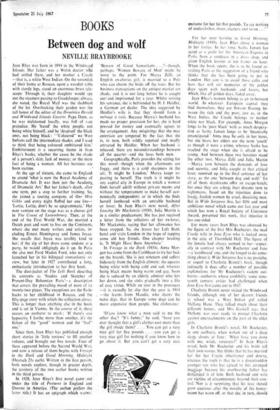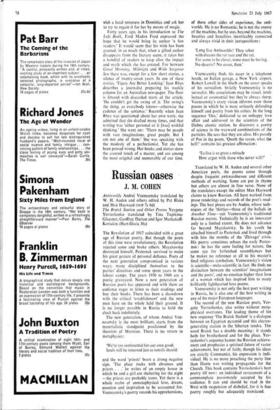Between dog and wolf BOOKS
NEVILLE BRAYBROOKE Jean Rhys was born in 1894 in the Windwaol- Islands. Her father was a Welsh doctor AO had settled there, and her mother a Creole —that is, a white West Indian. On the verandah of their home at Roseau, upon a wooden table with sturdy legs, stood an enormous brass tele- scope. Through it, their daughter would spy out the steamers passing to Guadeloupe; always, she noted, the Royal Mail was the shabbiest of the lot. Overlooking their garden was the tall house of the editor of the Dominica Herald and Windward Islands Gazette. Papa Dom, as he was nicknamed locally, was full of race prejudice. He 'hated' the white people, not being white himself, and he 'despised' the black ones, not being black : "'Coloured" we West Indians call the intermediate shades, and I used to think that being coloured embittered him.' Embitterment is a recurring theme in Jean Rhys's books, whether the cause be the shade of a person's skin; lack of money; or the mere fact of being a woman. All her heroines are born victims.
At the age of sixteen, she came to England to attend 'what is now the Royal Academy of Dramatic Art. It was then just the Academy,. of Dramatic Art.' But her father's death, after one term, put a stop to further training. So, she joined ,a touring company of Our Miss Gibbs and every night fluffed her one line—, Tonle, Lottie, don't be so epigrammatic.' Her next venture on the stage was as a chorus girl in The Count of Luxembourg. Then, at the end of the First World War, she married a Dutch poet and went to live on the Continent; where she met many writers and artists, in- cluding Ernest Hemingway and James Joyce. She recalls that Joyce was terribly kind to her; if the zip of her dress came undone at a party, he would obligingly do it up. In Paris she also met Ford Madox Ford, who not only launched her in his bilingual transatlantic re- view, but later in 1927 contributed a long, enthusiastic introduction to her first book.
The dust-jacket of The Left Bank describev its contents as 'Studies and Sketches of Present-Day Bohemian Paris'—a description that covers the prevailing mood of most of its twenty-two pieces. The exceptions are the flash✓ backs to her childhood in Roseau, and the fifty-page story with which the collection closes. This is longer than anything else in the book and is set in Vienna. In the course of it, there occurs an outburst to mark : 'If there's one hypocrisy I loathe more than another, it's the fiction of the "good" woman and the "bad" One.'
Since then, Jean Rhys has published enough short stories in 'little reviews' to fill another volume, and brought out five novels. Four of these appeared before the Second World War, and now a reissue of them begins with Voyage• in the Dark and Good Morning, Midnight (Deutsch 21s each). Written in the first person, both novels explore, though in greater depth, the territory of the two earlier books written- in the third person. • In 1928, Jean Rhys's first novel came. out under the title of Postures in England and Quartet in America. (The author prefers the latter title.) It has an epigraph ,Whieh warns: 'Beware of Good Samaritans . . .'—though, perhaps, 'Women Beware of Men' might be more to the point. For Marya Zelli, an English ex-chorus girl, is married to a Pole who can charm the birds off the trees. But his business transactions on the antique market are shady, and it is not long before he is caught out' and imprisoned for a year. Whilst serving his sentence, she is befriended by H. J. Heidler, a German art dealer. The idea suggested by Heidler's wife is that they should form a ménage a 'rob. Because Marya's husband has made no proper provision for her, she is hard pressed for money and eventually agrees to the arrangement. Any misgivings that she may entertain are tempered by the fact that she is, in turn, both wildly repulsed and madly attracted by Heidler. When her husband is released, there are misunderstandings between all the quartet—and she loses both men.
Geographically, Paris provides the setting for this novel—though when the afternoons are foggy, and there is a cold sharpness in the air, 'It might be London,' Marya keeps re- peating to herself. The truth is it might be any capital city in Europe in which a woman finds herself adrift without private means and without the temperament to make herself eco- nomically independent; or in which she finds herself lumbered with an unstable husband or lover. In Jean Rhys's next novel, After Leaving Mr Mackenzie (1930), Julia Martin is in a similar predicament. She has just received a letter from the solicitors of her ex-lover, Mr Mackenzie, saying that her allowance has been stopped. So, she leaves her Left Bank hotel and visits London in the hope of tapping some old boy friends. One chapter heading is, 'It Might Have Been Anywhere.'
In Voyage in the Dark (1934), Anna Mor- gan has come from the Caribbean to try her luck on the boards. She is just nineteen and suffers hideously from the English climate; she equates being white with being cold and sad, whereas being black means being warm and gay. Soon she is seduced by an elderly admirer who lets her down, and she sinks gradually into a life of easy virtue. While on tour in the provinces —it is casually let slip that the year is 1914 —she learns from Maudie, who shares the same digs, that in Europe some dogs can be more expensive than people. She elaborates:
'D'you know what a man said to me the other day? "It's funny," he said, "have you ever thought that a girl's clothes cost more than the girl inside them? . . You can get a very nice girl for five pounds . . . you can get a very nice girl for nothing if you know how to go about it. But you can't get a very nice costume for her for five pounds. To say nothing of underclothes, shoes, etcetera and so on ..." '
For her next heroine in Good Morning, Midnight (1939), Jean Rhys chose a woman in her forties. In her time. Sasha Jansen has acted as a guide for the American Express in Paris, been a vendeuse in a dress shop, and given English lessons at ten francs an hour. When the book opens, she is to be found re- visiting Paris at the suggestion of a friend who thinks that she has been going to pot in London. Her aim is to avoid those cafes and bars that will stir memories of the golden days spent with husbands and lovers, but *hich, like all golden days, faded away.
Jean Rhys's women belong to an in-between world. In whatever European capital they find themselves, they are flotsam floating be- tween the rich and the poor, just as, in the West Indies, the Creole belongs to neither white nor black. For example, Anna Morgan longs to be 'pure black' with as much despera- tion as Sasha Jansen longs to be 'financially emancipated.' Anna may be only in her teens, but she hears her elders use the term 'youth' as though it were a crime, whereas Sasha has reached the stage when she is afraid to be young. And between these two heroines stand the other two, Marya Zelli and Julia Martin —Marya torn between the demands of love and security, and Julia caught at that critical hour, summed up in the final sentence of her story, as the one 'between dog and wolf.' To all of them, daydreams offer an escape-hatch; but once they are asleep, their dreams turn to nightmares, based on the injustices done to lovely, foolish women by cruel, deceiving men. But in Wide Sargasso Sea, her fifth and most ambitious novel which came out last year and which has won a Royal Society of Literature Award, presented this week, that injustice is less one-sided.
Igor many years Jean Rhys was obsessed by the figure of the first Mrs Rochester, the mad Creole wife in Jane Eyre who is locked away in the attic of Thornfield Hall. The figure of the lunatic had always seemed to her—especi- ally in contrast with Mr Rochester and Jane —a 'cardboard' one, and she longed to do some- thing about it. Wide Sargasso Sea is no pastiche, or sequel to Charlotte Bronte's book, though indirectly it does offer a number of possible explanations for Mr Rochester's violent out- bursts—outbursts whose credibility some nine- teenth century critics had challenged when Jane Eyre first came out in 1847.
Charlotte Brontë never visited the Windward Islands, although one of her dearest friends at school was a West Indian girl called Mellany Hane. They talked much about their different homes, and Mrs Gasketl says that Mellany was ever ready to protect Charlotte against encroachments on the part of the elder girls.
In Charlotte Bronte's novel, Mr Rochester, in one outburst, when woken out of a deep sleep, shouts at Jane: 'What have you done with me, witch, sorceress?' In Jean Rhys's novel, both Mr Rochester and his bride tell their own stories. She thinks that he has married her for her Creole inheritance and dowry, whereas the truth is that he is a downtrodden younger son who has agreed to this arranged marikiage because his overbearing father has demanded it of him. Both husband and •wife are victims of circumstances beyond their con- trol.Islor is it surprising that his love should grow cautious after the novelty of the honey- moon has worn off, or that she, in turn, should visit a local sorceress in Dominica and ask her to try to regain it for her by means of magic.
Forty years ago, in his introduction to The Left Bank, Ford Madox Ford expressed the hope that he would bring its author 'a few readers.' It would seem that his wish has been granted, in so much that, when a gifted author disappears from the literary scene, it takes but a handful of readers to keep alive the impact and myth which she has created. For between Good Morning, Midnight and Wide Sargasso Sea there was, except for a few short stories, a silence of twenty-seven years. In one of these stories, 'Tigers Are Better Looking,' Jean Rhys describes a journalist preparing his weekly column for an Australian newspaper. The floor is littered with discarded starts of the article. `He couldn't get the swing of it. The swing's the thing, as everybody knows—otherwise the cadence of the sentence.' Recently when Jean Rhys was questioned about her own work, she admitted that she drafted many times, and that writing was 'either personal or it [was] wishful thinking.' She went on: 'There may be people with vast imaginations, great people. But I am not one of them.' She was speaking with the modesty of a perfectionist. Yet she has been proved wrong. Her books and stories show the assured touch of a master, and are among the most original and memorable of our time.































 Previous page
Previous page